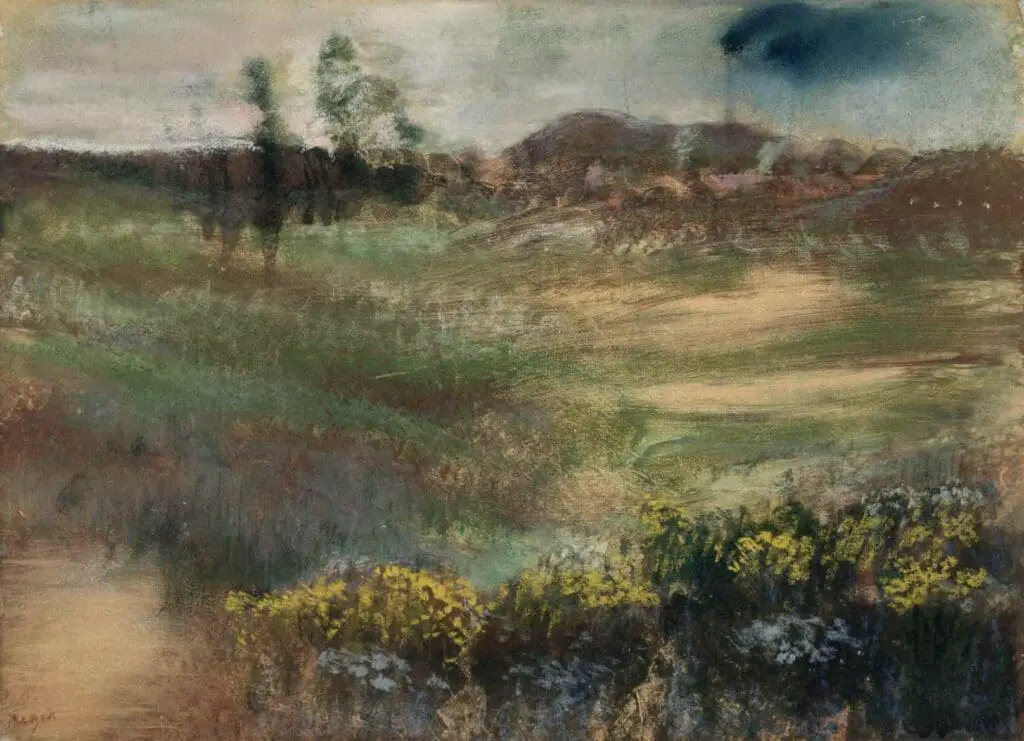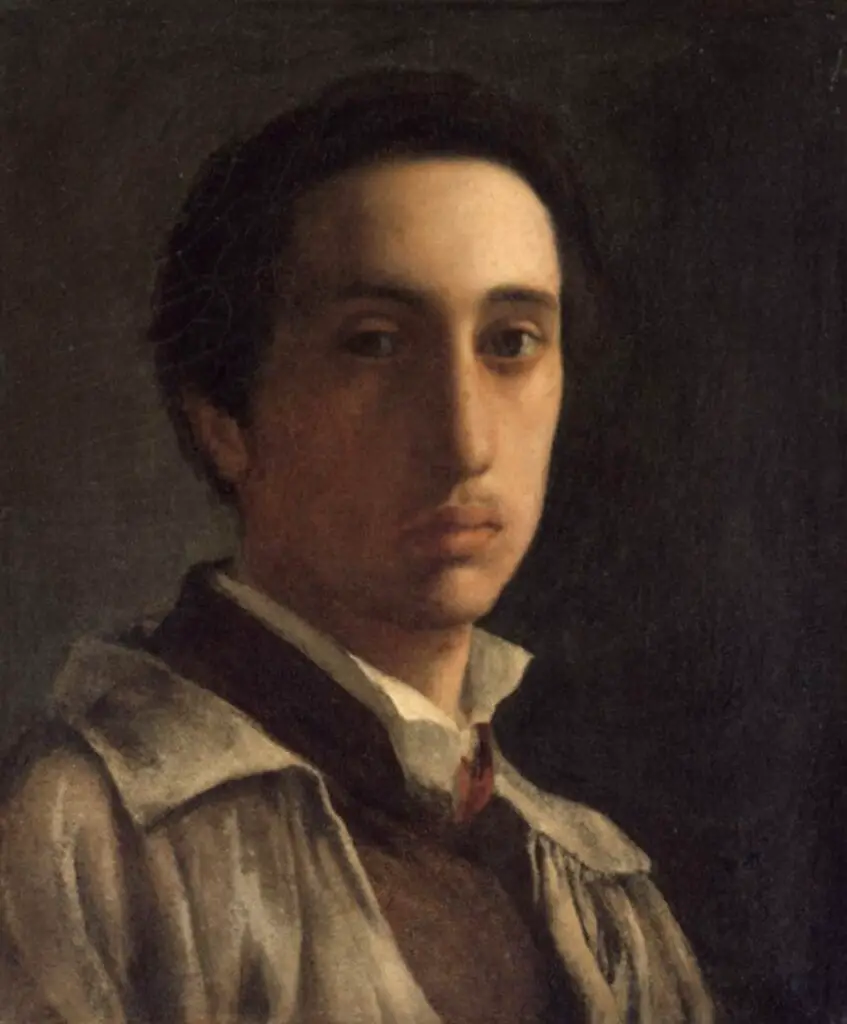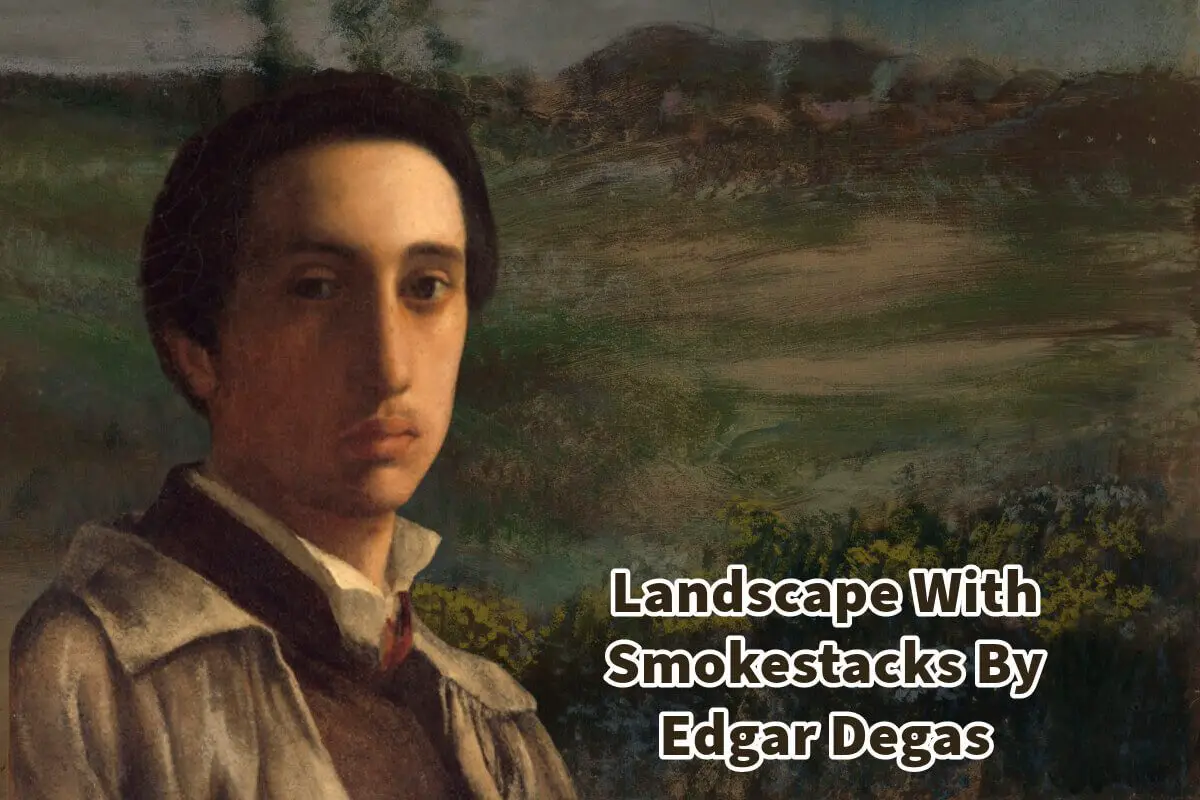Edgar Degas is widely regarded as one of the greatest artists in history, yet he stands out for predominantly painting indoors, within the confines of his studio.
This makes it all the more intriguing that he occasionally broke his usual routine to paint outdoors, aligning himself, at least momentarily, with other Impressionist artists of his era known for their plein-air works. “Landscape with Smokestacks” is a fascinating example of one of those rare instances when Degas stepped outside to capture the world in paint. Read on to delve deeper into this intriguing aspect of Degas’ artistic journey.
Table of Contents
- Exploring The Depths Of Edgar Degas’ Landscape With Smokestacks: A Mysterious Venture Into The Landscape Genre
- Brooding And Mysterious Landscapes
- Edgar Degas – The Complexity Of Interpretation Of Art
- Related Questions
Exploring The Depths Of Edgar Degas’ Landscape With Smokestacks: A Mysterious Venture Into The Landscape Genre
Edgar Degas remains an enigmatic figure in the world of art. Best known for his ethereal depictions of ballet dancers and intimate portrayals of modern urban life, Degas periodically ventured into landscapes—a genre primarily dominated by his Impressionist contemporaries during the 1870s and 1880s.

While Degas was notorious for avoiding open-air painting, his later years showed renewed interest in landscapes. His work “Landscape with Smokestacks” offers a fascinating glimpse into this lesser-known aspect of his artistic journey.
Edgar Degas – The Journey To Landscape Painting
Degas’ transition to landscapes did not occur overnight. In his early career phase, he traveled to Normandy’s coast in 1869 and produced pastel landscapes.
However, he mostly refrained from this genre during the peak Impressionist years, instead concentrating painting on the ballet and urban scenes in his studio, the artwork that would cement his legacy.
Interestingly, Degas’ perspective shifted in the 1890s. This change of heart was instigated by a trip through Burgundy in 1890, which inspired a series of landscapes.
But unlike his Impressionist contemporaries, Degas did not simply set up his easel in the open air and start painting – he used a monotype technique.
The Technique Of Monotype Explored
Degas was innovative not just in his choice of subjects but also in his techniques. The landscapes he produced in the 1890s, including “Landscape with Smokestacks,” were crafted using monotype, a unique method he had begun pioneering in the 1870s.
A monotype is created by drawing or painting with greasy printer’s ink directly onto a metal plate, then printed onto a sheet of paper. Generally, only one strong impression can be made from the plate, although occasionally, a second, fainter impression—known as a monotype cognate—can also be pulled.
Degas took this technique one step further by overlaying his monotypes with pastels, adding layers of complexity to his compositions.
On-the-Spot Vs. Memory
Degas’ technique varied for his monotypes. Some were created on location, responding directly to the landscape before him, while others were products of his imagination and memory.
“Landscape with Smokestacks” is believed to belong to the latter category. This technique of capturing ‘landscapes of memory’ starkly contrasted the objective, momentary captures of changing atmospheric conditions that artists like Claude Monet were known for.
Brooding And Mysterious Landscapes
“Landscape with Smokestacks” is particularly noteworthy for its air of mystery. Unlike Monet’s preoccupation with fleeting moments and atmospheric effects, Degas’ landscapes are rooted in a sense of brooding permanence.
These are not merely faithful representations of a particular location or moment; they are subjective interpretations suffused with melancholy or introspection.
Degas’ “Landscape with Smokestacks” is not an impressionistic celebration of nature but a layered, complex work that invites contemplation. The smokestacks in the distance bridge the natural world and industrial civilization, subtly hinting at the complexities and contradictions of modern life.
Edgar Degas – The Complexity Of Interpretation Of Art
Degas’ landscapes, including “Landscape with Smokestacks,” often present a problem for art historians and critics. On the one hand, they align with the broader aims of the Impressionist movement, focusing on contemporary life and pushing the boundaries of traditional artistic techniques.
On the other hand, these works represent a divergence from the central tenets of Impressionism, both in terms of subject matter and execution.

What’s clear is that Degas was not content to follow any prescribed path. Whether consciously or not, he extended the boundaries of Impressionism by showing that the movement could accommodate a broader range of approaches and subjects than previously thought.
His work defies easy categorization, challenging our understanding of what Impressionism can and cannot be.
Edgar Degas’ “Landscape with Smokestacks” is more than just a foray into the landscape genre; it’s an exercise in complexity and nuance. By opting for the monotype technique, Degas could bring his unique blend of observation and imagination to a subject matter his contemporaries monopolized.
His approach to landscapes offers an insight into the artist’s evolving relationship with Impressionism, a movement he helped to define yet never fully embraced.
While Degas may be most celebrated for his ballet dancers and urban scenes, works like “Landscape with Smokestacks” remind us that his artistic prowess was not confined to any single genre. Instead, it’s a testament to his ability to innovate and redefine boundaries—making him a complex figure worthy of continued study and admiration.
Anita Louise Art is dedicated to art education, great artists, and inspiring others to find and create their art. We love art that uplifts and aspires. #ArtToMakeYouSmile! #ArtToMakeYouHappy!
If you want to see any of my art, you can find out more by clicking here. If you are interested in what inspires me and my paintings, you can discover more by clicking here.
We have a free newsletter and would love you to be part of our community; you can subscribe to the newsletter by clicking here. If you have any questions, I would be happy to talk to you. You can reach me, Anita, by clicking here.
Subscribe to our Anita Louise Art YouTube Channel filled with great videos and information by clicking here.
Join us for our podcast “5 Minutes With Art.” Spend just 5 minutes a week with us to discover and learn about great art and artists. You can find out more about our podcast by clicking here.
Related Questions
Similarities Of Expressionism And Impressionism Art And Their Differences
Impressionism and Expressionism art movements started in Europe, but the Impressionism movement started before the Expression art movement. Each movement has different looks of art, which are distinguishable. Even though they are both different art movements, there are still some similarities.
By clicking here, you can learn more by reading Similarities Of Expressionism And Impressionism Art And Their Differences.
What Are The Main Characteristics Of Minimalism Art?
Minimalism art started in New York City in the 1960s. The minimalist artist would use limit their use of lines, shapes, and colors in their art. The artwork had no trace of the artist’s emotions in the art. Minimalism art is considered an extreme form of abstract art. The most important geometric shapes in minimalism art are the square and rectangle.
You can discover more by reading What Are The Main Characteristics Of Minimalism Art? by clicking here.
What Are The Characteristics Of The Arts And Crafts Movement?
The Arts and Craft Movement started in Britain and swept Europe and the United States. The movement started to become both popular and very influential in the late 19th century and changed how many artists worldwide viewed their art. It also changed how artists saw the design of not just their artwork but also buildings, fabrics, wallpaper, parks, cities, and objects in their homes and offices.
You can learn more by reading What Are The Characteristics Of The Arts And Crafts Movement? by clicking here.


